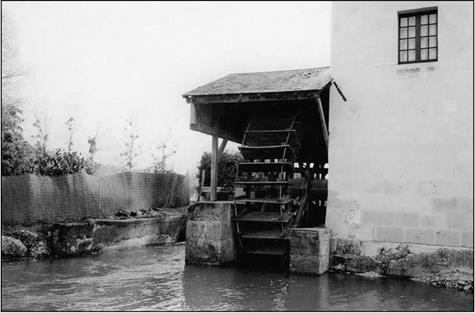The Mills of the Middle Ages
The death throes of the aqueducts and the end of the Roman way of life
With the fall of the Roman Empire, the Romano-Hellenistic urban lifestyle in the West begins to retreat rapidly. The roots of this lifestyle are found in the Cretan cities of the Bronze Age. The forums where citizens met to discuss the business of the city are among the victims of the inward-turning that characterized this troubled period. The thermal baths where water so freely flowed disappear; the beautiful public fountains dry up. The cities degrade; new urban streets are unpaved and have neither sewers nor water pipes. Water is no longer delivered, it must be drawn from wells or from the river. This is likely why Lyon, for example, moves down from the heights of Fourviere to the banks of the Saone.
The aqueducts fall into ruin one by one between the 4th and 6th centuries AD, due as much to neglect as to the deliberate action of invaders. And yet these symbols of Roman civilization remain marks of prestige for the powerful ecclesiastics who, one way or another, manage to restore them sufficiently to supply their palaces in the 8th or 9th century. These personages include Aldric, the bishop of Le Mans; Dieudonne the abbot of Saint- Germain d’Auxerre; Rigobert, the archbishop of Reims; and Didier, the bishop of Cahors. Charlemagne himself has the aqueduct of Aix-la-Chapelle1 restored. In Rome proper, the popes restore several aqueducts to service in the 7th and 8th centuries, to provide water for the mills that they build on the Janicule and for the baptismal fonts of churches.[460] [461] But the people, for their own water needs, must go directly to the Tiber, or dig wells.
It is difficult to determine the number of water mills in use at the end of the Roman Empire. But it is evident that in the 8th and 9th centuries the water mill was widely used in Carolingian agricultural domains in Switzerland and in the northern half of France, whether these domains be lay (the villas) or monastic.[462] The Benedictine abbeys that spring up in this period follow the rule of Saint Benoit which dictates that the monasteries be provided with water and a mill:
“(the monastery should be) set up so that everything that is needed can be found there: water,
a mill, a garden and shops so that one can practice diverse trades within the enclosure.”[463]
Where they exist, these water supply systems are nothing more than modest aqueducts of wood (as at the Swiss monastery of Sant-Gall) or derivations from small rivers (as at the monastery of Fulda in Germany). The importance of these early monasteries to the conservation of hydraulic techniques and the approach to the medieval revival is subject to debate.[464]
In the 9th century, the Viking invaders from the north travel up the rivers and manage to plunge western Europe into obscurity – it is even forgotten that the earth is round.
With the end of widespread famines and the development of commerce in northern and western Europe, the revival begins in the 10th century, inaugurating a long period of economic and demographic expansion. This expansion will last up until the Hundred Years’ War (1337 – 1453) and the great plague of 1348 – 1349. In the 12th century the monasteries rediscover and reproduce certain ancient authors such as Aristotle and Gallien, from Arab translations brought back from the crusades. These Arab documents are brought from al-Andalus or from Sicily where the Norman kingdom founded in 1061 welcomes Arab and Jewish intellectuals.
|
Figure 9.1 The Borde mill at Saint-Jacquest des Guerets, on a race from the Loir, below the medieval site of Troo in the Sarthe department of France (photo by the author) |







Leave a reply